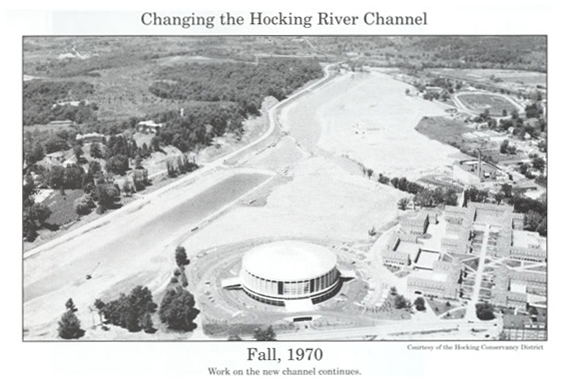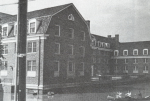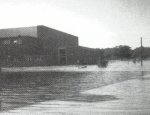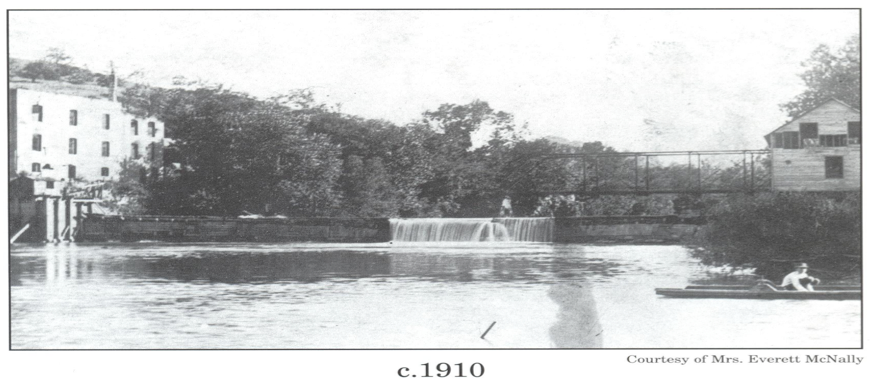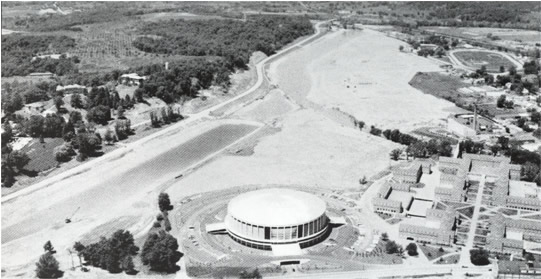Athens Local Protection Project (ALPP)
Construction began March 9, 1969
Construction completed September 8, 1971
Project dedicated May 13, 1972
ALPP History
The Athens Local Protection Project (ALPP) did not become a reality overnight. According to Mr. Donald Johnson (the first secretary-treasurer of the conservancy district) there were studies of the Hocking River in August 1948, August 1950, and again in June of 1956. There was also a study of the Coolville area for the possibility of navigation in 1889. There were several more studies completed before the ALPP could become a reality.
In 1963, the Hocking River flooded the entire valley, including Athens, forcing many people to be evacuated from their homes. This flood event devastated the Hocking River basin, but it would not be the last time flooding would devastate the valley. Repeated flood events led to the formation of the Hocking Conservancy District to address these issues.
Another major flood of the Hocking River occurred in March of 1964, cresting higher than the flood of 1963. Flooding is but one of Mother Nature's natural disasters that many communities are forced to navigate. The flood of 1964 caused large-scale damage throughout the watershed and led to the creation of the Athens Local Protection Project.
On March 11th, 1964 United States President Lyndon B. Johnson accompanied by Ohio Gov. James A. Rhodes and Mr. Fred E. Morr, (Director of ODNR) conducted an aerial survey of the area during the peak of the March 1964 flood. President Johnson expressed a keen interest in finding a solution to this flooding problem. The State of Ohio had a concerned financial interest due to having several million dollars invested in buildings for Ohio University. They wanted to protect their investment and provide for the safety of their students.
1964 Flood, Athens, Ohio
Photographs from “As Time Goes By: A Pictorial Journal of Athens, Ohio” from the book by Marjorie S. Stone.
This would have been the scene witnessed by President Johnson.
At the request of the President of the United States, the USACOE began to study the Hocking River Basin. The Corps prepared and presented an interim report on solving the flooding problem by a river relocation and levee project (Local Protection Project) for the Athens area, with further study of other villages and cities for potential LPP's along the Hocking River. A reservoir on Clear Creek in Hocking County was to be studied as well. This report was submitted in March 1965.
The process of seeing the Athens project become a reality involved numerous agencies reviewing and agreeing to the plan. The following agencies were required to review and accept the plan, The Corps Division Office in Cincinnati, The Chief Engineer Office in Washington, The Board of Engineers for River and Harbors, The House and Senate Committees on Public Works, The House of Representatives, and the U.S. Senate. After acceptance by these agencies, Congress authorized the ALPP in December 1965.
Being authorized does not mean that money had been made available to construct the project. The COE needed funds to develop the plans and design for the ALPP. Congress annually appropriates money for Public Works Projects. In December 1966 the COE received the funding for planning of the ALPP.
Planning money is not construction money. During the next Congressional session initial money for construction was in the appropriation bill passed in 1967, for $200,000.00. Construction was scheduled to start in 1969, with a $1 million item in the President's budget for the next fiscal year.
Among some of the obstacles that the District had to address for the ALPP were the accommodation for the location of Sheltering Arms Hospital (O’Bleness Memorial Hospital); plans for Ohio University; B&O railroad; ODOT extension of SR 682 through the State Hospital grounds from Route 56 to Richland Av. which required re-alignment of the channel and moving the bridge at Richland Av.; ODOT bypass with the SR 33/50 highway with interchanges at E. State St., and Stimson Av.; removal of the Mill St. bridge and construction of a replacement bridge at Stimson Av.; ODOT requiring the allowance for 2 new bridges crossing the Hocking River at the east end of Athens to pick up US Route 50; in which all of these changes required the project to be lengthened by about 1 mile from the original plan. Other considerations for this project to proceed were the relocation of sewage lines under the channel, which required a new lift station to be constructed at Richland Avenue to tie into the existing sewage lines, and the relocation of other utilities.
The project involved acquiring the necessary lands, easements, and rights-of-way, relocating the Hocking River, installation of three storm water pumping stations, revision of storm sewer lines, along with necessary street and bridge considerations.
According to the caption, this bridge was an all-iron structure started in 1902. It spanned one hundred and forty-six feet. Age had taken its toll on the bridge and was demolished when the Athens Local Protection Project was built in 1970. A bridge just a few hundred feet downstream at Stimson Avenue, served as its replacement.
Although the design project for Athens provides excellent protection against flooding, there remains the potential for damaging floods.
In 1974, the Board of Directors for the Hocking Conservancy District dedicated the Athens Local Protection Project “The Donald R. Johnson Channel” as a tribute for his work for the people and communities within the Hocking Conservancy District.
In tribute to Donald R. Johnson (1904-1973) who faithfully, devotedly, and effectively served as Secretary-Treasurer of the Hocking Conservancy District from its inception until the completion of the Athens Flood Protection Project (1972) of which this channel is a part. “Every valley shall be exalted” (Isaiah 40:4)
This plaque dedicated to Mr. Donald R. Johnson is located on the left bank, west of Richland Avenue, between the Hocking River and the Silas Bingham House (formerly the Ohio University Visitors Center). This is the site of the original ground breaking ceremony for the Athens Local Protection Project.
